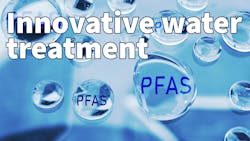Harnessing the power of piezoelectricity for water treatment
People in the water industry must evolve with a rapidly changing industry, which means exploring new ways to achieve goals. One method is to apply piezoelectricity to water treatment. Materials with piezoelectric properties produce electric charges under mechanical stress. How might this approach improve processes for industrial professionals?
Removing persistently present chemicals
People commonly refer to per- and polyfluoroalkyl substances (PFAS) as “forever chemicals” because these components do not break down in the body or environment. PFAS have made life more convenient, contributing to the desirable properties of nonstick pans or waterproof clothing. However, given how long they persist, manufacturers have moved away from using them, leaving drinking water and wastewater professionals to determine how to remove PFAS from water.
Current processes include removing them from water with biosolids or filtering them out with activated carbon or specific membranes. However, piezoelectricity offers another possibility. Researchers focused on methods to break down a class of PFAS called perfluorooctane sulfonates (PFOS). One challenge of destroying PFOS concerns long chains of carbon-fluorine bonds that typically need significant energy to break.
The group developed piezoelectric nanomaterials that look similar to sand. When immersed in an ultrasonic bath, they become a catalyst and have an electrical charge. The electricity triggers a reaction that breaks down the PFOS. A mass spectrometer confirmed the degradation of 90.5% of the molecules, but there is a caveat. The group worked with a PFOS concentration of 4 milligrams per liter, but it appears in concentrations of less than 1 microgram per liter in the world’s lakes and rivers.
A lower concentration of PFOS in the water would take longer to degrade. That detail will be essential to know if people move this method from the lab to the real world and see if the performance changes.
Discovering sustainable water treatment methods
Some of the most applicable ways to use piezoelectricity fit easily into existing processes. That is why some researchers have explored how people might power their phones with piezoelectric materials built into their insoles or that respond to other repetitive movements.
Piezoelectric ceramics change thicknesses on the millimeter scale with applied forces. People have studied how to maximize that effect, such as through amplification, and have adapted it to various applications, including to solve pressing problems.
Water professionals are particularly interested in how piezoelectricity could make water treatment more sustainable. Many current methods involve advanced oxidation and a compound called persulfate. However, they are resource-intensive and environmentally harmful, emphasizing the need for alternatives.
Researchers found an updated approach that uses piezoelectric materials that clean the water once activated by making the persulfate work. It is particularly beneficial because the required pressure can come from natural, already-existing sources, such as currents, meaning this option does not require extra energy.
The team is also examining other materials and tackling challenges such as insufficient energy generation. Once improved and applied to real-world situations, they believe this way of treating water could become multipurpose, such as by converting unwanted substances in the water into useful things.
This work is in the early stages, but it facilitates scientists uncovering potential process improvements that would lead to a more sustainable future.
Tapping into piezoelectricity’s potential for a school project
Improving water treatment with piezoelectricity is also an option for forward-thinking young people, as shown by the nonprofit Stockholm International Water Institute. It oversees an annual competition for teens and young adults who solve major, relevant problems with school projects.
One of the 2022 entrants was a project that investigates using piezoelectricity to harvest potable water from local sources, such as lakes and rivers. The students sourced brass piezoelectric discs and connected them to an oscilloscope to measure the produced voltage. They also got creative and used various everyday items — garden and shower hoses and a drinking-water faucet — to model river conditions.
The school-aged researchers then conducted eight trials across two test setups. One finding was that piezoelectricity most efficiently generates power when water droplets are the energy source. Additionally, the investigation indicated that drop-formation physics results in controllable, reliable energy production that is scalable and applicable across locations.
Moreover, the participants envision everyone from community members to national agencies using this self-contained method. Similar to the previous example, this approach sources the energy for the treatment from the water’s movement. Related findings also suggest it is a sustainable option that substantially reduces the ecological damage and resource depletion associated with energy transport. Since the tested methods cost nothing to run after the system’s installation, they could appeal to people who want measurable results without ongoing costs.
Piezolectricity’s place in pioneering water treatments
These fascinating examples show why piezoelectricity deserves continued exploration as people continue investigating how to meet the water treatment industry’s needs. Ongoing commitments will improve methods and show researchers where to focus their efforts.
Although the ways to make water safe to use have changed due to technological advancements, the world’s need for that liquid will remain present and grow with population increases. Remaining open to piezoelectricity — and other creative options — will keep the water industry relevant and well-prepared for the future.
About the Author

